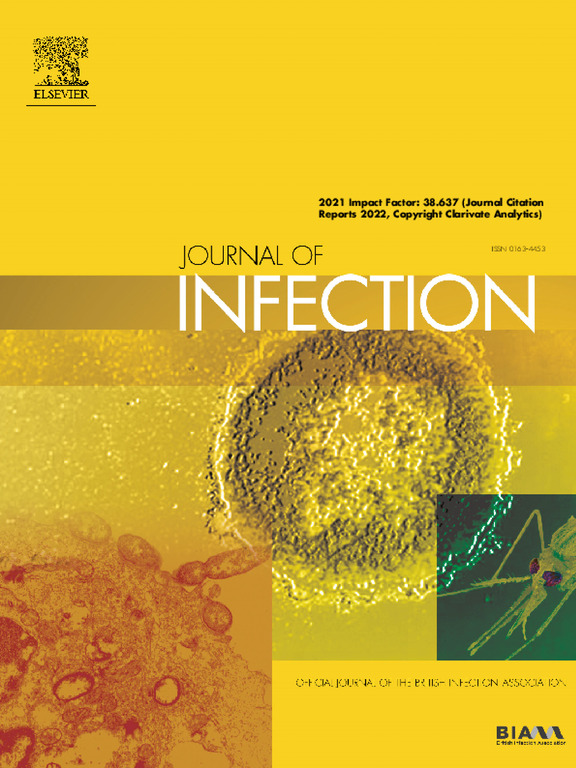肠杆菌血液感染中抗生素耐药性的机器学习和临床医生预测。
IF 14.3
1区 医学
Q1 INFECTIOUS DISEASES
引用次数: 0
摘要
背景:革兰氏阴性血流感染患者在没有积极治疗的情况下存在严重不良后果的风险,但确定谁具有抗微生物药物耐药性(AMR)以靶向经验性治疗具有挑战性。方法:采用XGBoost机器学习模型预测肠杆菌血液感染患者对7种抗生素的耐药性。模型使用英国牛津郡的医院和社区数据进行训练,用于2017年1月1日至2021年12月31日期间血培养阳性的患者。通过将预测结果与2022年1月1日至2023年12月31日测试数据集中的最终微生物学结果以及临床医生的处方进行比较,评估了模型的性能。结果:4709次感染事件用于模型训练和评估;抗生素耐药率为7-67%。在hold -out试验数据中,7种抗生素的耐药预测性能相似(auc为0.680 [95%CI 0.641-0.720]至0.737[0.674-0.797])。当将物种鉴定(可在24小时后获得)作为模型输入时,大多数抗生素的性能得到改善(auc为0.723[0.652-0.791]至0.827[0.797-0.857])。在接受β -内酰胺治疗的患者中,临床医生的处方导致70%的患者接受了活性β -内酰胺:44%的患者过度治疗(比需要的治疗范围更广),26%的患者最佳治疗(最窄的活性药物),30%的患者治疗不足(非活性β -内酰胺)。没有物种数据的模型预测可能导致79%的患者接受活性β -内酰胺:45%过度治疗,34%最佳治疗,21%治疗不足。结论:预测血液感染中的AMR对临床医生和模型都具有挑战性。尽管表现平平,但在优先考虑抗菌剂管理的环境中,机器学习模型仍然可以使接受积极经验治疗的患者比例比目前的临床实践提高9%。本文章由计算机程序翻译,如有差异,请以英文原文为准。
Machine learning and clinician predictions of antibiotic resistance in Enterobacterales bloodstream infections
Background
Patients with Gram-negative bloodstream infections are at risk of serious adverse outcomes without active treatment, but identifying who has antimicrobial resistance (AMR) to target empirical treatment is challenging.
Methods
We used XGBoost machine learning models to predict antimicrobial resistance to seven antibiotics in patients with Enterobacterales bloodstream infection. Models were trained using hospital and community data from Oxfordshire, UK, for patients with positive blood cultures between 01-January-2017 and 31-December-2021. Model performance was evaluated by comparing predictions to final microbiology results in test datasets from 01-January-2022 to 31-December-2023 and to clinicians’ prescribing.
Findings
4709 infection episodes were used for model training and evaluation; antibiotic resistance rates ranged from 7–67%. In held-out test data, resistance prediction performance was similar for the seven antibiotics (AUCs 0.680 [95%CI 0.641–0.720] to 0.737 [0.674–0.797]). Performance improved for most antibiotics when species identifications (available ∼24 h later) were included as model inputs (AUCs 0.723 [0.652–0.791] to 0.827 [0.797–0.857]). In patients treated with a beta-lactam, clinician prescribing led to 70% receiving an active beta-lactam: 44% were over-treated (broader spectrum treatment than needed), 26% optimally-treated (narrowest spectrum active agent), and 30% under-treated (inactive beta-lactam). Model predictions without species data could have led to 79% of patients receiving an active beta-lactam: 45% over-treated, 34% optimally-treated, and 21% under-treated.
Conclusions
Predicting AMR in bloodstream infections is challenging for both clinicians and models. Despite modest performance, machine learning models could still increase the proportion of patients receiving active empirical treatment by up to 9% over current clinical practice in an environment prioritising antimicrobial stewardship.
求助全文
通过发布文献求助,成功后即可免费获取论文全文。
去求助
来源期刊

Journal of Infection
医学-传染病学
CiteScore
45.90
自引率
3.20%
发文量
475
审稿时长
16 days
期刊介绍:
The Journal of Infection publishes original papers on all aspects of infection - clinical, microbiological and epidemiological. The Journal seeks to bring together knowledge from all specialties involved in infection research and clinical practice, and present the best work in the ever-changing field of infection.
Each issue brings you Editorials that describe current or controversial topics of interest, high quality Reviews to keep you in touch with the latest developments in specific fields of interest, an Epidemiology section reporting studies in the hospital and the general community, and a lively correspondence section.
 求助内容:
求助内容: 应助结果提醒方式:
应助结果提醒方式:


